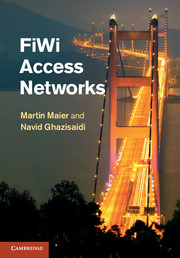6 - WiFi
from Part III - Wireless access networks
Published online by Cambridge University Press: 05 January 2012
Summary
Wireless fidelity (WiFi) has been envisioned by the WiFi alliance as a single worldwide adopted standard for high-speed wireless local area networking. The term WiFi denotes wireless local area network (WLAN) technology based on IEEE 802.11 specifications. In this chapter, we provide an overview of the salient features and most important specifications of legacy and next-generation WLANs.
Legacy WLAN
WLANs based on IEEE 802.11 have become very popular in providing different data services. Figure 6.1 shows the general WLAN architecture, where an access point (AP) is connected to the Internet and/or other WLANs through a wired network infrastructure, referred to as the distribution system (DS). In this architecture, wireless stations (STAs) communicate with their associated AP using the medium access control (MAC) protocols defined in the IEEE 802.11 specifications.
Due to the use of unlicensed frequency bands (2.4 GHz with 14 distinct channels and 5 MHz) in IEEE 802.11b/g with data rates of up to 11/54 Mbps, WiFi networks have gained much attention (Kuran and Tugcu [2007]). During the last decade, various standards and/or amendments have been approved or initiated to enhance IEEE 802.11 based WiFi technology. Table 6.1 summarizes the IEEE 802.11 WiFi standard family.
The initial IEEE 802.11 physical (PHY) layer includes: (i) frequency hopping spread spectrum (FHSS), (ii) direct sequence spread spectrum (DSSS), and (iii) infrared (IR). IEEE 802.11b uses high-rate DSSS (HR-DSSS), while IEEE 802.11g deploys orthogonal frequency division multiplexing (OFDM). The IEEE 802.11 MAC layer deploys the distributed coordination function (DCF) as a default access technique.
- Type
- Chapter
- Information
- FiWi Access Networks , pp. 75 - 85Publisher: Cambridge University PressPrint publication year: 2011



